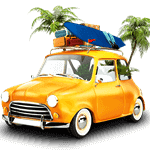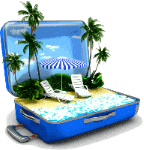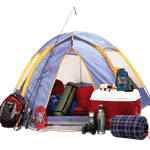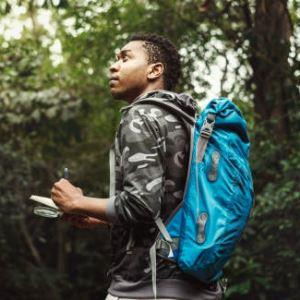 Kenya's transport system offers a dynamic and sometimes bewildering experience for German tourists. From buzzing city traffic to long-distance travel across the savannah, navigating the country's transport network requires both curiosity and caution. Understanding how public, private, and informal systems operate will make your trip more enjoyable and significantly less stressful. In urban areas like Nairobi, Mombasa, and Kisumu, public transport is dominated by matatus colorful, privately-run minibuses that serve fixed routes but often lack formal schedules. For many locals, matatus are a lifeline, offering an affordable and accessible way to move around. As a visitor, you might find them overwhelming at first. They are usually packed, feature loud music, and their routes can be confusing. However, once you learn to navigate them, they become an authentic and efficient way to explore the cities. For those wondering how to use matatus in Kenya as a German tourist, it’s essential to ask locals, carry small denominations of Kenyan shillings, and remain vigilant of your surroundings. Motorcycle taxis, known as boda bodas, offer quick and nimble transport, especially during peak traffic hours. They can get you through the tightest jams, but they come with higher safety risks. If you choose this option, make sure the driver provides a helmet and rides safely. Ride-hailing apps like Uber, Bolt, and Little are widely used in major cities and are ideal for travelers who prefer safer and more predictable alternatives. For intercity travel, buses and long-distance shuttles such as Easy Coach or Modern Coast connect most urban centers. These are budget-friendly and relatively comfortable, but journeys can be long due to road conditions and stops. Kenya also boasts a modern train system known as the Standard Gauge Railway (SGR), connecting Nairobi to Mombasa. The SGR is reliable, secure, and offers both economy and first-class options. Despite the variety of choices, transport in Kenya isn’t without challenges. Roads are often in poor condition, especially outside major cities, and traffic congestion is common. Planning ahead, checking travel times, and using GPS or transport apps can help mitigate delays. Additionally, always keep personal belongings secure and avoid traveling late at night. Cultural etiquette on Kenyan transport includes basic politeness like greeting fellow passengers and offering your seat to elders. Patience goes a long way when dealing with delays or route changes, and a friendly attitude often opens doors to help from locals. With the right approach, Kenya’s transport network can be navigated with ease and even enjoyment. Embrace the local rhythm, stay alert, and your journey through the country will be as memorable as the destinations themselves.
Kenya's transport system offers a dynamic and sometimes bewildering experience for German tourists. From buzzing city traffic to long-distance travel across the savannah, navigating the country's transport network requires both curiosity and caution. Understanding how public, private, and informal systems operate will make your trip more enjoyable and significantly less stressful. In urban areas like Nairobi, Mombasa, and Kisumu, public transport is dominated by matatus colorful, privately-run minibuses that serve fixed routes but often lack formal schedules. For many locals, matatus are a lifeline, offering an affordable and accessible way to move around. As a visitor, you might find them overwhelming at first. They are usually packed, feature loud music, and their routes can be confusing. However, once you learn to navigate them, they become an authentic and efficient way to explore the cities. For those wondering how to use matatus in Kenya as a German tourist, it’s essential to ask locals, carry small denominations of Kenyan shillings, and remain vigilant of your surroundings. Motorcycle taxis, known as boda bodas, offer quick and nimble transport, especially during peak traffic hours. They can get you through the tightest jams, but they come with higher safety risks. If you choose this option, make sure the driver provides a helmet and rides safely. Ride-hailing apps like Uber, Bolt, and Little are widely used in major cities and are ideal for travelers who prefer safer and more predictable alternatives. For intercity travel, buses and long-distance shuttles such as Easy Coach or Modern Coast connect most urban centers. These are budget-friendly and relatively comfortable, but journeys can be long due to road conditions and stops. Kenya also boasts a modern train system known as the Standard Gauge Railway (SGR), connecting Nairobi to Mombasa. The SGR is reliable, secure, and offers both economy and first-class options. Despite the variety of choices, transport in Kenya isn’t without challenges. Roads are often in poor condition, especially outside major cities, and traffic congestion is common. Planning ahead, checking travel times, and using GPS or transport apps can help mitigate delays. Additionally, always keep personal belongings secure and avoid traveling late at night. Cultural etiquette on Kenyan transport includes basic politeness like greeting fellow passengers and offering your seat to elders. Patience goes a long way when dealing with delays or route changes, and a friendly attitude often opens doors to help from locals. With the right approach, Kenya’s transport network can be navigated with ease and even enjoyment. Embrace the local rhythm, stay alert, and your journey through the country will be as memorable as the destinations themselves.
Comparative Overview of Transport Modes in Kenya
| Transport Mode | Cost (EUR) | Safety Level | Best For |
|---|---|---|---|
| Matatu | 0.20 - 0.70 | Moderate | Short city commutes |
| Boda Boda | 0.50 - 1.50 | Low | Quick local trips |
| Taxi/Ride-Hailing | 2.00 - 10.00 | High | Safe, direct city travel |
| Intercity Bus | 5.00 - 13.00 | Moderate | Travel between major towns |
| SGR Train | 6.00 - 20.00 | High | Travel between Nairobi & Mombasa |
Public Transport in Kenya: What Every Visitor Should Know
Kenya's public transport system is as diverse as its landscapes, offering a colorful blend of informal and formal transit options. For visitors from Germany, particularly those used to highly regulated and punctual transport services, this can be both intriguing and overwhelming. The most iconic component of Kenya's transport culture is the matatu privately-owned minibuses that crisscross city routes and rural highways. They are loud, fast, inexpensive, and creatively decorated, often featuring vibrant artwork and blasting music. While they operate on relatively fixed routes, there are no strict schedules, which makes local knowledge essential for successful navigation. For first-time visitors, it helps to ask locals for the right matatu to board and where to get off. Routes are loosely defined and often indicated only by hand signals from the touts or by destination names on the windshield. Prices are affordable, typically ranging from 30 to 100 Kenyan Shillings (0.20 to 0.70 EUR), and fares are paid to the conductor on board. Matatus are often crowded, and standing passengers are common during peak hours. Boda bodas, or motorcycle taxis, are another popular form of transport for short distances, especially in areas with narrow roads or heavy traffic. While quick and affordable, they carry a higher risk due to poor road infrastructure and lax safety enforcement. Helmets are legally required, but not always provided. If you choose to ride one, opt for providers available through ride-hailing platforms like Bolt or SafeBoda, which tend to enforce stricter safety standards. City buses, although present in major urban centers like Nairobi and Mombasa, are less prevalent than matatus and serve a smaller portion of the population. They are slightly more structured and are usually safer, albeit slower and less frequent. Another viable option is ride-hailing services such as Uber, Bolt, and Little Cab. These are especially useful for tourists unfamiliar with local geography, offering GPS tracking, price transparency, and a more secure experience. For longer journeys between cities, intercity buses and shuttles such as Modern Coast, Ena Coach, and Easy Coach provide scheduled services and varying degrees of comfort. Prices are reasonable and vary depending on distance and class. The Standard Gauge Railway (SGR) between Nairobi and Mombasa offers a smooth, modern alternative with first and economy class cabins, and is well-regarded for its punctuality and safety. One common concern among first-time visitors is this: is public transport safe for German travelers in Kenya? The answer depends on the mode and situation. While matatus and boda bodas can be chaotic and occasionally risky, many tourists use them successfully with caution. Ride-hailing and the SGR offer greater reliability and comfort. Kenya's public transport can be a practical and immersive way to experience daily life in the country. With a bit of preparation and awareness, it's entirely possible to use it effectively and safely.
Understanding Matatus, Boda Bodas, and Local Bus Routes
Navigating the intricate network of matatus, boda bodas, and city buses in Kenya may seem like a daunting task for first-time German visitors, but with a little insight, it can be a fascinating and practical way to explore the country. These modes of transport are deeply woven into Kenya’s daily life, offering both a cost-effective and immersive travel experience. Matatus are privately owned minibuses that operate along most city and rural routes. They are known for their vibrant artwork, energetic music, and erratic driving patterns. Although they can appear chaotic, matatus are the heartbeat of Kenyan urban transport. They are not bound by strict schedules but generally follow set routes. Fares are usually between 30 and 100 Kenyan Shillings (about 0.20 to 0.70 EUR), depending on the distance. Payment is made to the conductor onboard, who also shouts out destinations and assists passengers with boarding. While traveling by matatu, it's important to keep your belongings secure and avoid peak hours if you prefer less crowded conditions. Tourist-friendly mobile apps and Google Maps can help determine matatu routes, though local advice is often more accurate. Boda bodas, on the other hand, are motorbike taxis ideal for navigating heavy traffic or reaching locations inaccessible by matatu. They are fast and affordable but come with safety concerns. Always wear a helmet and use ride-hailing apps like SafeBoda or Bolt for greater security. City buses offer a more structured but less frequent service than matatus. Operated by Nairobi City County and private companies, these buses follow specific routes and are generally safer and quieter. However, they are slower and can be delayed due to traffic or infrequent scheduling. For German tourists looking for reliability, ride-hailing services such as Uber and Bolt offer a balance between cost and comfort. These apps provide estimated fares, driver ratings, and GPS tracking, making them a convenient option for unfamiliar areas. When it comes to tips for Germans using public buses in Nairobi, the key is to have small denominations of local currency, avoid traveling too late in the evening, and be polite and patient with fellow passengers. Keep an eye on your belongings and be prepared for delays, especially during rush hour. Learning to use Kenya’s public transport whether by matatu, boda boda, or bus adds a layer of cultural understanding and local connection that can significantly enrich your travel experience.
Getting Around Kenyan Cities: Options, Costs, and Challenges
Getting around Kenya's major cities can be both exciting and perplexing, especially for German travelers unfamiliar with the region’s informal transport culture. Nairobi, the capital, is a sprawling urban center with a mix of colonial-era infrastructure, modern development, and deeply local commuting habits. Knowing your transport options in advance can save you time and help you avoid confusion. In Nairobi, traffic congestion is a daily reality, especially during peak hours (7:00–9:00 AM and 4:30–7:00 PM). For short distances, matatus remain the cheapest and most common form of public transport. A matatu ride typically costs between 30 and 100 Kenyan Shillings (0.20–0.70 EUR), depending on distance and time of day. However, these minibuses can be loud and overcrowded, and they may not adhere to formal timetables. As such, they require a bit of local knowledge to use confidently. Ride-hailing apps such as Uber, Bolt, and Little are popular and widely used in cities like Nairobi and Mombasa. They are more expensive than matatus but offer greater comfort, safety, and reliability. A 5 km trip may cost anywhere from 300 to 600 KES (2–4 EUR). These services are ideal for travelers who prefer GPS navigation, cashless transactions, and rated drivers. Taxis can also be hired directly, but they often charge higher rates and may not always use meters. For long-distance travel between cities, intercity buses and shuttles are a practical choice. Companies such as Modern Coast, Ena Coach, and Easy Coach run scheduled services between major cities, with fares typically ranging from 800 to 2000 KES (5–13 EUR). The buses are generally safe and offer varying comfort levels based on the class of ticket. The Standard Gauge Railway (SGR), which connects Nairobi and Mombasa, is a standout option for intercity transport. It is efficient, punctual, and offers both economy and first-class seating. Tickets cost between 1000 and 3000 KES (6–20 EUR). The train journey offers a scenic and relaxed way to travel between Kenya’s largest cities. When arriving at or departing from Nairobi's Jomo Kenyatta International Airport (JKIA), travelers can use airport taxis, hotel shuttles, or app-based rides. A taxi ride to the city center takes 20 to 45 minutes depending on traffic and costs approximately 1500–2500 KES (10–17 EUR). For newcomers, the German traveler guide to Nairobi airport transport would advise pre-booking transfers, confirming driver identity, and avoiding informal taxis to ensure safety and reliability. While transport in Kenyan cities may not match the structure and punctuality of German systems, a flexible mindset, some local advice, and the strategic use of modern travel apps can go a long way toward making city travel smoother and more manageable. Apps like Google Maps, Uber, and Bolt help in planning routes, estimating fares, and avoiding risky transport choices, especially for those unfamiliar with the layout of cities like Nairobi or Mombasa. It is advisable to always allow extra time for delays, particularly during rush hour, when traffic congestion can be significant. Engaging with local residents can also provide valuable insights into alternative routes or safe times to travel. Keeping emergency contacts handy and staying informed about neighborhood-specific advisories enhances safety and confidence. With these precautions, German visitors can navigate Kenyan cities with greater ease and experience local transport as an enriching part of their cultural journey.
Nairobi Transport Guide for Tourists and Foreign Visitors
Nairobi, Kenya's capital and largest city, is a bustling hub of activity where modern skyscrapers meet vibrant street life. For German tourists, navigating the city's transport landscape may seem unfamiliar at first, but with a bit of planning, it can become an efficient and rewarding experience. The key lies in understanding your options and making informed choices depending on safety, cost, and convenience. The city offers a range of transport modes including matatus (minibuses), boda bodas (motorbike taxis), public buses, and ride-hailing services. Matatus are inexpensive and run on numerous routes across Nairobi. However, they can be chaotic, especially during rush hours, and might not offer the predictability or comfort that international travelers are used to. Boda bodas are useful for quick short-distance trips but are best avoided in heavy traffic or at night due to safety concerns. Public buses operated by Nairobi City County and private firms are a safer alternative to matatus, particularly for those who prefer scheduled service and quieter rides. They are generally clean, affordable, and reliable on high-traffic routes. However, the frequency and route coverage are limited, especially outside the city center. For the most secure and convenient travel, especially for first-time visitors, ride-hailing apps like Uber, Bolt, and Little are highly recommended. They offer cashless payments, real-time GPS tracking, and the ability to view driver ratings in advance. These services are ideal for airport pickups, travel within the central business district, or exploring suburban areas. Knowing how Germans can book safe taxis in Nairobi is crucial for peace of mind. The safest method is to use a well-known ride-hailing app, confirm the driver's details, and ensure the car registration matches what's displayed in the app. It's also helpful to share your ride details with a friend or family member for added safety. If ride-hailing apps aren't available, hotels and registered taxi stands can also arrange trustworthy taxi services. While it may take a day or two to adapt to Nairobi's transportation system, German travelers will find that the variety of options gives them flexibility and access to every part of the city. As always, it's important to stay alert, avoid displaying valuables, and consult locals or hotel staff when in doubt about routes or safe travel times. With these tips in mind, getting around Nairobi can be a comfortable and culturally enriching experience.
What to Know About Safety and Etiquette on Kenyan Transport
 Traveling across Kenya offers an incredible opportunity to experience diverse landscapes and vibrant cultures. However, safety and etiquette remain key considerations, especially for German tourists unfamiliar with the norms of local transport systems. From matatus and boda bodas to ride-hailing services and car rentals, being well-prepared ensures a smoother and more secure journey. When using public or shared transport like matatus or boda bodas, it’s important to stay alert and cautious. Choose vehicles that appear well-maintained, and never board a matatu that looks overcrowded or unsafe. While boda bodas are convenient, especially in congested areas, they carry significant risk due to unpredictable driving and lax enforcement of safety regulations. Always wear a helmet and prefer operators linked to ride-hailing apps that follow safety protocols. Etiquette plays a crucial role in creating a pleasant experience. Greet fellow passengers with a polite nod or verbal greeting, and be mindful of personal space even in tight quarters. It's customary to offer your seat to elderly passengers or those with small children. Keep conversations, especially phone calls, discreet, and avoid eating strong-smelling food during transit. If you're handling cash payments for fare, try to offer exact change or smaller denominations. Ride-hailing services such as Uber, Bolt, and Little provide a safer alternative to matatus and offer conveniences like GPS tracking, cashless payment, and driver ratings. However, always verify that the license plate and driver match what's shown in the app. It's also wise to share your ride details with someone you trust, particularly when traveling at night. An increasingly popular option among tourists is car rental. Renting a car in Kenya as a German citizen is relatively straightforward with major providers operating in Nairobi and other large cities. A valid international driving permit (IDP) and passport are typically required, along with a credit card for payment. While renting a vehicle offers the freedom to explore Kenya on your own terms, it also demands familiarity with local road conditions and traffic rules, which can differ significantly from those in Germany. Defensive driving is crucial, and it's advisable to avoid night driving, especially outside urban centers. Understanding both the safety precautions and cultural expectations of Kenya’s transport landscape can significantly enhance your travel experience. Transport in Kenya operates differently than in Germany, so taking time to understand the local systems can help you avoid confusion and reduce stress. From the informal yet lively matatus to the more structured train services, each mode offers unique insights into Kenyan life. German visitors should be prepared for irregular schedules, potential delays, and varying standards of road quality. Flexibility is key, especially in cities like Nairobi and Mombasa where traffic can be intense. Using mobile navigation apps and planning routes in advance can save valuable time. Learning basic Swahili greetings or transport phrases also helps build goodwill with locals. Most importantly, adopting a respectful and open-minded attitude will enrich your experience. With common sense, basic preparation, and a respectful approach, German travelers can confidently explore Kenya's vibrant transport options and enjoy the journey as much as the destination.
Traveling across Kenya offers an incredible opportunity to experience diverse landscapes and vibrant cultures. However, safety and etiquette remain key considerations, especially for German tourists unfamiliar with the norms of local transport systems. From matatus and boda bodas to ride-hailing services and car rentals, being well-prepared ensures a smoother and more secure journey. When using public or shared transport like matatus or boda bodas, it’s important to stay alert and cautious. Choose vehicles that appear well-maintained, and never board a matatu that looks overcrowded or unsafe. While boda bodas are convenient, especially in congested areas, they carry significant risk due to unpredictable driving and lax enforcement of safety regulations. Always wear a helmet and prefer operators linked to ride-hailing apps that follow safety protocols. Etiquette plays a crucial role in creating a pleasant experience. Greet fellow passengers with a polite nod or verbal greeting, and be mindful of personal space even in tight quarters. It's customary to offer your seat to elderly passengers or those with small children. Keep conversations, especially phone calls, discreet, and avoid eating strong-smelling food during transit. If you're handling cash payments for fare, try to offer exact change or smaller denominations. Ride-hailing services such as Uber, Bolt, and Little provide a safer alternative to matatus and offer conveniences like GPS tracking, cashless payment, and driver ratings. However, always verify that the license plate and driver match what's shown in the app. It's also wise to share your ride details with someone you trust, particularly when traveling at night. An increasingly popular option among tourists is car rental. Renting a car in Kenya as a German citizen is relatively straightforward with major providers operating in Nairobi and other large cities. A valid international driving permit (IDP) and passport are typically required, along with a credit card for payment. While renting a vehicle offers the freedom to explore Kenya on your own terms, it also demands familiarity with local road conditions and traffic rules, which can differ significantly from those in Germany. Defensive driving is crucial, and it's advisable to avoid night driving, especially outside urban centers. Understanding both the safety precautions and cultural expectations of Kenya’s transport landscape can significantly enhance your travel experience. Transport in Kenya operates differently than in Germany, so taking time to understand the local systems can help you avoid confusion and reduce stress. From the informal yet lively matatus to the more structured train services, each mode offers unique insights into Kenyan life. German visitors should be prepared for irregular schedules, potential delays, and varying standards of road quality. Flexibility is key, especially in cities like Nairobi and Mombasa where traffic can be intense. Using mobile navigation apps and planning routes in advance can save valuable time. Learning basic Swahili greetings or transport phrases also helps build goodwill with locals. Most importantly, adopting a respectful and open-minded attitude will enrich your experience. With common sense, basic preparation, and a respectful approach, German travelers can confidently explore Kenya's vibrant transport options and enjoy the journey as much as the destination.
Staying Safe and Respectful while Traveling in Kenya
Staying safe and showing respect while using Kenyan transport is essential for a smooth and culturally enriching experience. The country’s diverse and often informal transit systems require a mix of alertness, patience, and cultural awareness. Here’s a practical guide for German tourists to remain safe and respectful on the go:
- Choose well-maintained transport options: Avoid using matatus or boda bodas that appear poorly maintained or overcrowded. Select vehicles that look roadworthy and drivers who behave responsibly.
- Use official and app-based services: Opt for ride-hailing apps like Uber, Bolt, or Little, especially at night or when alone. These services allow you to verify the driver and share your ride with trusted contacts.
- Be mindful of your belongings: Always keep personal items like phones, wallets, and passports secure and close to your body, especially in crowded vehicles or busy stations.
- Show cultural courtesy: Greet fellow passengers politely and offer your seat to elders or people with children. Loud phone calls or disruptive behavior can be considered rude.
- Use cash thoughtfully: Carry small denominations of Kenyan shillings to make paying for transport easier and avoid disputes over change.
- Plan your route in advance: Use apps like Google Maps or ask locals for guidance before boarding matatus or city buses. This reduces confusion and the likelihood of ending up in unsafe areas.
- Avoid night travel: Where possible, avoid using public transport after dark, particularly in unfamiliar or poorly lit areas. If necessary, rely on hotel-arranged transfers or app-based taxis.
- Consider renting a car with caution: Renting a car offers flexibility but comes with challenges. Roads may be poorly marked, and driving styles vary. Use this option only if you're confident navigating foreign traffic laws and local conditions.
- Learn a few Swahili phrases: A basic “hello” or “thank you” in Swahili goes a long way in earning local goodwill and making communication smoother.
- Stay informed and flexible: Keep an eye on local news or travel advisories. Traffic and transport conditions in cities like Nairobi can change quickly, so flexibility is key.
By blending preparation, situational awareness, and cultural respect, German tourists can enjoy a safe and respectful experience while exploring Kenya’s vibrant transport landscape.






